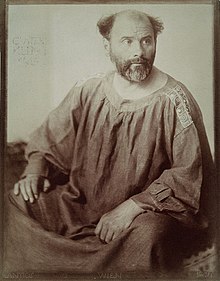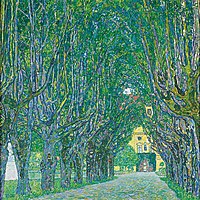Gustav Klimt
| Gustav Klimt | |
|---|---|
 | |
| Thông tin cá nhân | |
| Sinh | |
Tên khai sinh | Gustav Klimt |
Ngày sinh | 14 tháng 7, 1862 |
Nơi sinh | |
| Rửa tội | 16 tháng 7, 1862 |
| Mất | |
Ngày mất | 6 tháng 2, 1918 (55 tuổi) |
Nơi mất | |
Nguyên nhân | tai biến mạch máu não |
| An nghỉ | Nghĩa trang Hietzing |
| Giới tính | nam |
| Quốc tịch | |
| Dân tộc | Người Áo |
| Tôn giáo | Công giáo |
| Nghề nghiệp | họa sĩ, nhà thiết kế, nghệ sĩ đồ họa, người phác họa, họa viên kiến trúc |
| Gia đình | |
Bố | Ernst Klimt |
Mẹ | Anna Klimt |
Anh chị em | Ernst Klimt, Georg Klimt |
Hôn nhân | không có |
Người tình | Emilie Louise Flöge, Serena Lederer |
Con cái | Gustav Ucicky, Otto Zimmermann |
| Thầy giáo | Ferdinand Laufberger, Julius Victor Berger |
| Học sinh | Egon Schiele |
| Lĩnh vực | Họa sĩ |
| Sự nghiệp hội họa | |
| Trường phái | Tượng trưng |
| Trào lưu | Tân nghệ thuật |
| Chủ đề | hình thể người phụ nữ |
| Tác phẩm | Judith and the Head of Holofernes, Chân dung Adele Bloch-Bauer I, Nụ hôn |
Ảnh hưởng tới
| |
| Chữ ký | |
 | |
| Gustav Klimt trên IMDb | |
Gustav Klimt (14 tháng 7 năm 1862 – 6 tháng 2 năm 1918) là một họa sĩ theo trường phái tượng trưng (Symbolism) người Áo và là một trong những thành viên xuất chúng nhất của phong trào Art Nouveau Viên (Ly khai Wien). Các tác phẩm chính của ông bao gồm tranh, tranh tường, bức phác họa và nhiều tác phẩm nghệ thuật khác, nhiều tác phẩm trong số này đang được trưng bày ở gallery Ly khai Wien. Chủ đề hàng đầu của ông là mô tả hình thể của người phụ nữ[1] và các tác phẩm vẽ bằng bút chì của ông được mô tả nét khêu gợi quyến rũ của phụ nữ dù khỏa thân hay ăn mặc kín đáo.
Tác phẩm chọn lọc[sửa | sửa mã nguồn]






- Quý bà cầm quạt
- Tranh vẽ trên trần Đại học Vienna
- Tranh khảm ở Palais Stoclet tại Brussels
- Fable (1883)
- The Theatre in Taormina (1886-1888)
- Auditorium in the Old Burgtheater, Vienna (1888)
- Portrait of Joseph Pembauer, the Pianist and Piano Teacher (1890)
- Ancient Greece II (Girl from Tanagra) (1890 - 1891)
- Portrait of a Lady (Frau Heymann?) (1894)
- Music I (1895)
- Love (1895)
- Sculpture (1896)
- Tragedy (1897)
- Music II (1898)
- Pallas Athene (1898)
- Flowing water (1898)
- Portrait of Sonja Knips (1898)
- Fish Blood (1898)
- Schubert at the Piano (1899)
- After the Rain (Garden with Chickens in St Agatha) (1899)
- Nymphs (Silver Fish) (1899)
- Mermaids (1899)
- Philosophy (1899–1907) [2]
- Nuda Veritas (1899)
- Portrait of Serena Lederer (1899)
- Medicine (Hygieia) (1900–1907)
- Music (Lithograph) (1901)
- Judith I (1901)
- Buchenwald (Birkenwald) (1901)
- Gold Fish (To my critics) (1901–1902)
- Portrait of Gertha Felsovanyi (1902)
- Portrait of Emilie Floge (1902)
- Beech Forest (1902)
- Beech Forest I (1902)
- Beethoven Frieze (1902) [3][4]
- Beech woods (1903)
- Hope (1903)
- Pear Tree (1903)
- Life is a struggle(1903)
- Jurisprudence (1903–1907) [5]
- Water Serpents I (1904–1907)
- Water Serpents II (1904–1907)
- The Three Ages of Woman (1905)
- Portrait of Margaret Stonborough-Wittgenstein (1905)
- Farm Garden (Flower Garden) (1905–1906)
- Farm Garden with Sunflowers (1905-1906)
- The Stoclet Frieze (1905-1909)
- Portrait of Fritsa Reidler (1906)
- Sunflower (1906-1907)
- Hope II (1907-1908)
- Danaë (1907)
- Portrait of Adele Bloch-Bauer I (1907)
- Poppy Field (1907)
- Schloss Kammer on the Attersee I (1908)
- Nụ hôn (1907 - 1908)
- Lady with Hat and Feather Boa (1909)
- The Tree of Life (1909)
- Judith II (Salomé) (1909)
- Black Feather Hat (Lady with Feather Hat) (1910)
- Schloss Kammer on the Attersee III (1910)
- The Park (1910)
- Death and Life (1911)
- Farm Garden with Crucifix (1911-1912)
- Apple Tree (1912)
- Forester's House, Weissenbach on Lake Attersee (1912)
- Portrait of Mada Primavesi (1912)
- Portrait of Adele Bloch-Bauer II (1912)
- The Virgins (Die Jungfrau) (1913)
- The Church in Cassone (1913)
- Semi-nude seated, reclining (1913)
- Semi-nude seated, with closed eyes (1913)
- Portrait of Eugenia Primavesi (1913-1914)
- Lovers, drawn from the right (1914)
- Portrait of Elisabeth Bachofen-Echt (1914)
- Semi-nude lying, drawn from the right (1914-1915)
- Portrait of Friederike Maria Beer (1916)
- Houses in Unterach on the Attersee (1916)
- Death and Life (1916)
- Garden Path with Chickens (1916)
- The Girl-Friends (1916-1917)
- Woman seated with thighs apart, drawing (1916-1917)
- The Dancer (1916 - 1918)
- Leda (destroyed) (1917)
- Portrait of a Lady, en face (1917-1918)
- The Bride (chưa hoàn thành) (1917-1918)
- Adam and Eve (chưa hoàn thành) (1917-1918)
- Portrait of Johanna Staude (chưa hoàn thành) (1917-1918)
Tham khảo[sửa | sửa mã nguồn]
- ^ " The most important element of his fame is his reputation as a master of eroticism". Fleidel, Gottfried: Gustav Klimt 1862-1918 The World in Female Form, p. 14. Benedikt Taschen, 1994.
- ^ “Bản sao đã lưu trữ”. Bản gốc lưu trữ ngày 11 tháng 8 năm 2006. Truy cập ngày 16 tháng 6 năm 2009.
- ^ http://www.ibiblio.org/wm/paint/auth/klimt/klimt.beethoven-frieze1.jpg
- ^ http://www.ibiblio.org/wm/paint/auth/klimt/klimt.beethoven-frieze2.jpg
- ^ “Bản sao đã lưu trữ”. Bản gốc lưu trữ ngày 11 tháng 3 năm 2007. Truy cập ngày 16 tháng 6 năm 2009.
Liên kết ngoài[sửa | sửa mã nguồn]
| Wikimedia Commons có thêm hình ảnh và phương tiện truyền tải về Gustav Klimt. |
- "Adele's Wish" Documentary film on the Bloch-Bauer court case (Republic of Austria v. Altmann)
- Gallery of works by Gustav Klimt at Zeno.org (tiếng Đức)
- Gustav Klimt: Painting, Design and Modern Life in Vienna 1900 Lưu trữ 2009-10-01 tại Wayback Machine exhibition at Tate Liverpool, 2008
- Klimt Film IMDB page
- www.Gustav-Klimt.com Cuộc đời và sự nghiệp
- Tác phẩm của Gustav Klimt Lưu trữ 2015-09-24 tại Wayback Machine

